What if a newly planted orchard didn’t have to spend its first few years filling space and could start producing a crop of high-quality fruit in the second leaf?
That’s the idea behind Dale Goldy’s new planting in Quincy, Washington.
All the fertilizer that growers apply to push young trees to fill space creates an imbalance in the trees that can reduce fruit quality, Goldy said. Some cultivars are particularly nitrogen-sensitive. For growers and marketers trying to introduce to the market a new variety, from new orchards, it means they might not be putting their best fruit forward at first.
“It takes time for the tree to get off that imbalance,” he said. “I tried to figure out how we could overcome some of that.”
His proposed solution to shorten those juvenile years: a 3-foot by 6-foot system, planted with nursery trees that were already full-height at 7 feet tall. Six-foot row spacing sounds pretty extreme to most apple growers, where 10 feet is the new narrow, but Goldy, who owns Gold Crown Nursery, is used to farming nursery trees at 5-foot spacings.
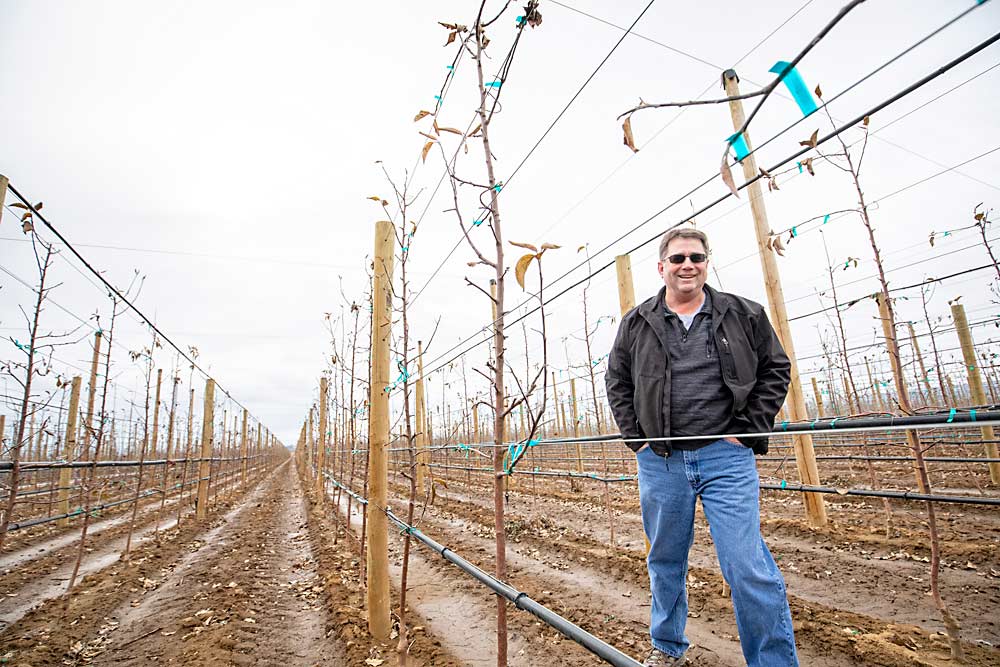
This idea of growing the nursery directly into the orchard is sometimes used in Europe to create ultrahigh-density pedestrian plantings, said Stefano Musacchi, tree fruit physiologist at Washington State University. Combining well-developed nursery trees with high-density planting allows growers to start cropping very early. Goldy’s approach, producing trees to perfectly fit his system, should similarly set the stage for a high level of precision farming, he said.
“The orchard that Dale is envisioning is kind of the summary of the good practices of orchard management. It’s an engineering orchard,” Musacchi said. “It’s really an integration of the nursery with the orchard that’s novel for Washington.”
The trees
Serving as his own nursery, Goldy had the advantage of tailoring the trees to his system. He planted big trees, 7 feet tall, like a “knipboom tree we didn’t knip,” Goldy said, referring to the process of heading back the scion in its second year to induce branching in that style of nursery production.
“Instead of growing large feathers, he wants short ones with nice angles, so there are lots to pick from to fit the system,” Musacchi said. Some of the training typically done in the first years in the orchard is done in the nursery instead, more efficiently. Then, “you go to the orchard with a tree that’s already performing,” he said.
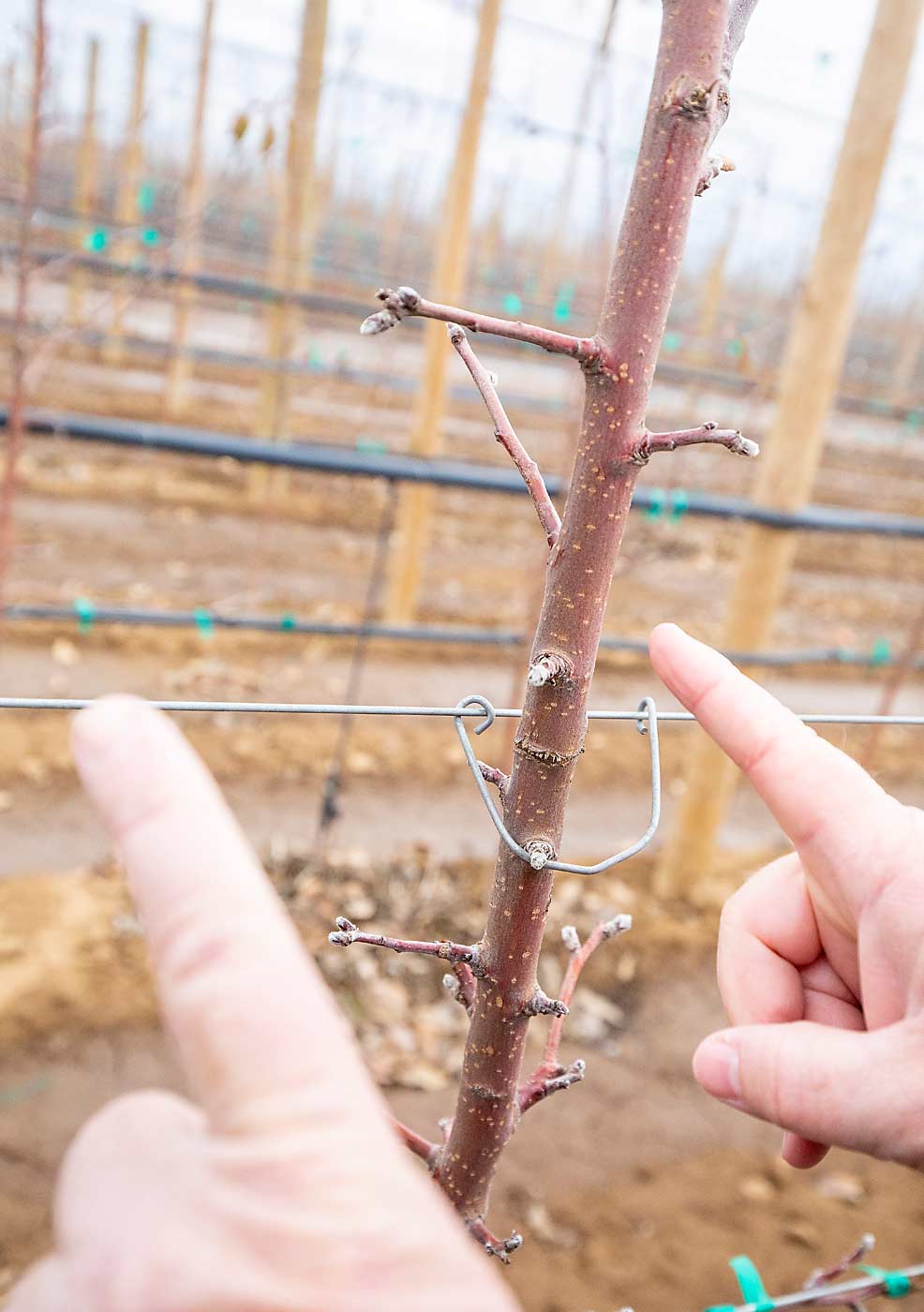
Goldy’s Minneiska (the apple marketed as SweeTango) trees started with a bench graft onto Geneva 935 rootstocks in January 2017 and were grown in the nursery until transplanting in May 2019. It’s a different way to use the two years it typically takes to produce a standard nursery tree, so it doesn’t cost that much more, he said.
Interest in such trees is growing as the industry moves toward fruiting wall systems with less room for branches, said Cornell University physiologist Terence Robinson (see “Bye to big branches” on Page 28).
“We could do better with a 7-foot-tall tree with 20 short feathers instead of a 6-foot-tall tree with five strong feathers,” he said. “The knip style induces that really long branch. In the past, that was a great advance, but I’m looking at the next advance.”
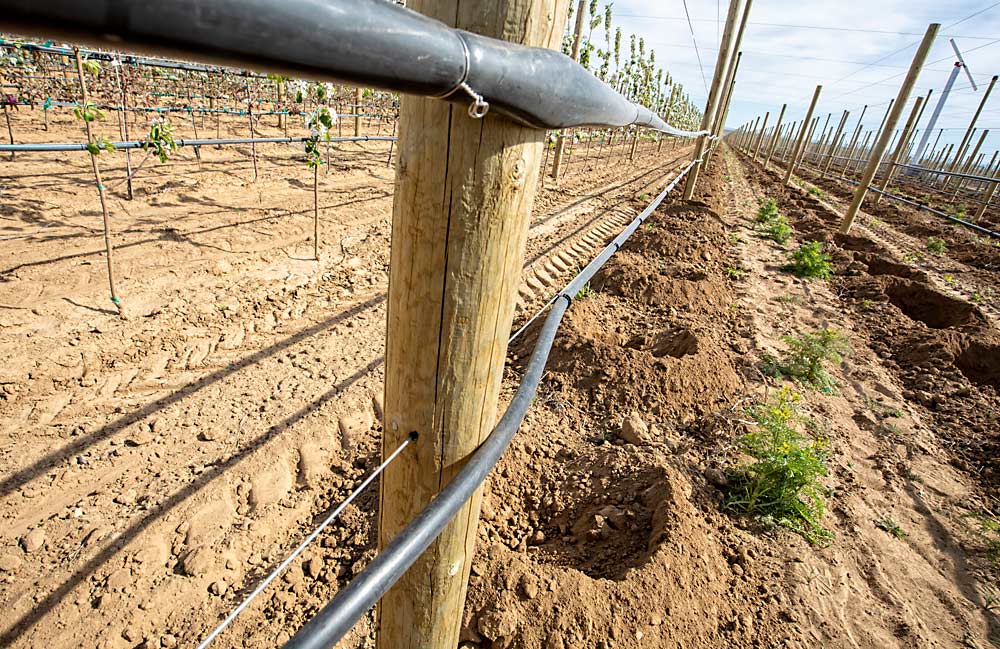
Goldy selected G.935 assuming that he would need a little extra push to get the trees cropping early, but since rootstocks are not tested under these conditions, it’s simply his best guess.
“I actually want the rootstock to help me with vigor, without fertilizing,” he said. “The whole idea is to use transplant shock to keep the trees in control and fill space, not to be in a situation where we are pushing.”
After planting, he applied only 16 pounds of nitrogen per acre, compared to upward of 100 pounds per acre when growers need to fill space. That should be good news for Honeycrisp and some of its descendants, such as Minneiska, that are very nitrogen-sensitive, and it should lower fire blight risk.
“Not every tree grows well high on nitrogen like Gala,” Goldy said. “I want to leave the fertilizer in the nursery.”
Early producing system
The 3-foot by 6-foot planting translates to 2,074 trees per acre. Goldy said he opted to give more in-row space to allow “light windows between the layers of fruit” for better color, compared to the shade a super spindle system can create. To push production up to 100 bins per acre, however, the rows then had to shrink.
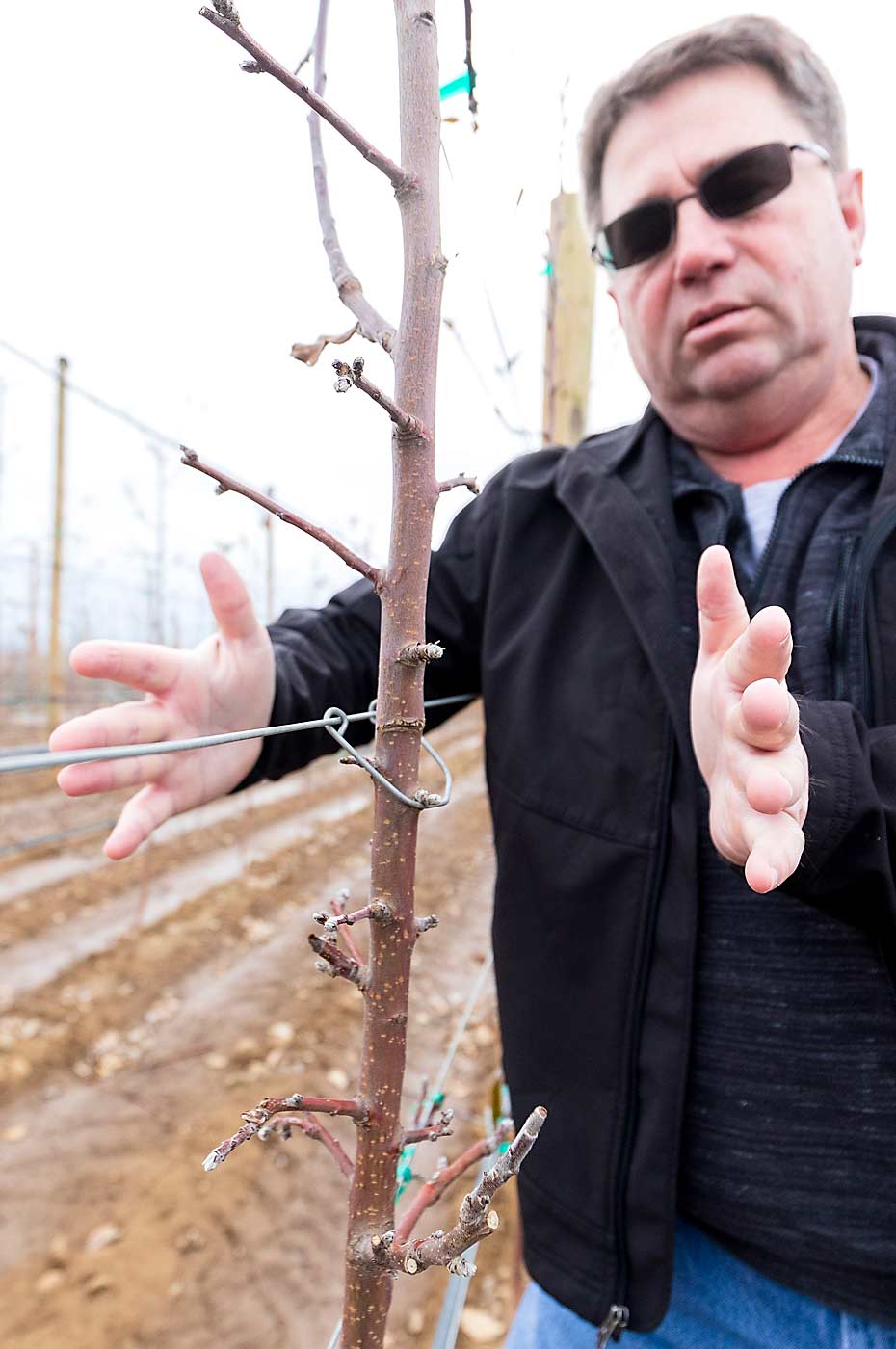
He expects 30 to 35 bins per acre on his second-leaf trees.
“People look at this and see a massive amount of money,” Goldy said. He estimates the investment at $50,000 an acre, including the retail price of the trees, at around $18,000. But, he thinks the tree cost is the wrong thing for growers to focus on when it comes to planting costs.
“We’ve got to forget about the price of the tree. Yes, that’s easy for a nurseryman to say, but people spend $12,000 to $15,000 a year farming an orchard that’s pre-productive,” Goldy said. “If you don’t get a commercial crop until the fourth leaf, you have to capitalize all of year one and year two and year three.”
Robinson said most growers don’t look at the cost that way — the cost of farming the baby trees gets absorbed by the rest of the operation. Growers miss the opportunity cost of starting with small trees, he said.
Growers understandably want to save money when they look at the price of new plantings, Musacchi said, “but they are not considering how much money they are spending to train those trees to become good trees.”
Thinking about it that way, it may cost more to grow a sleeping eye or bench graft into a productive tree, compared to the cost of his trees, Goldy said.
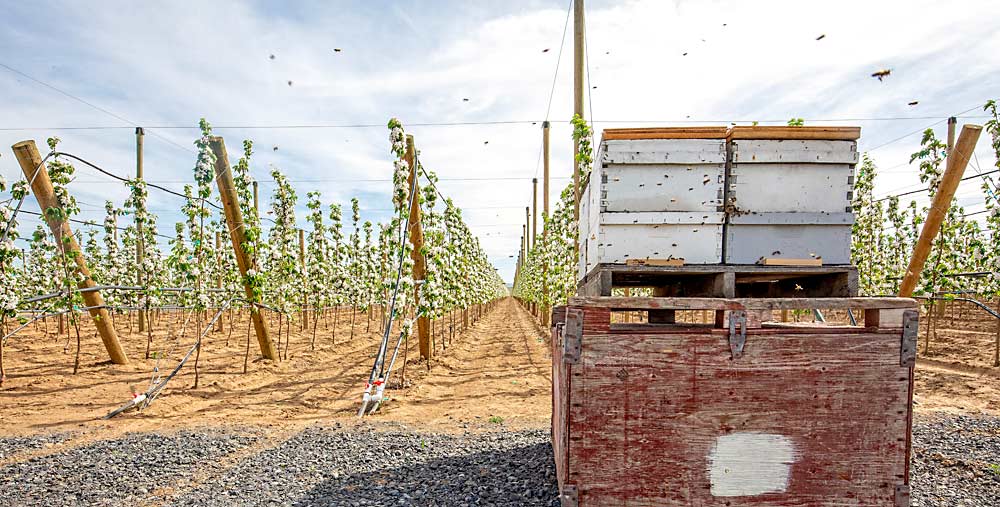
Efficient farming
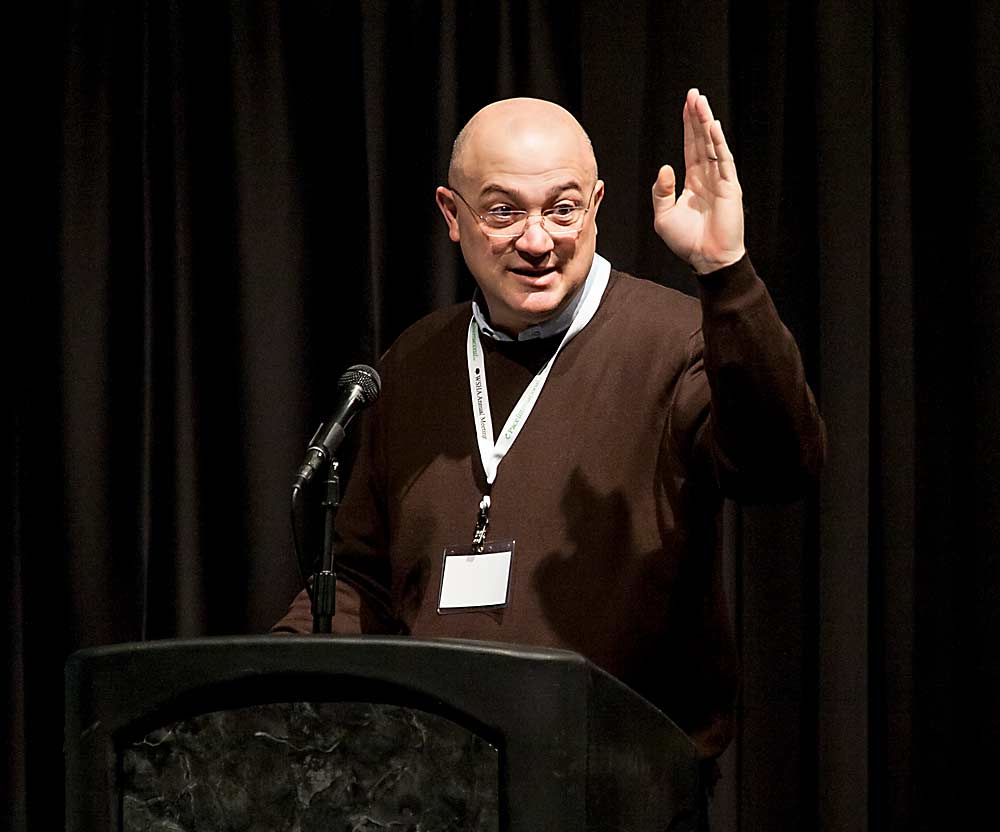
Goldy plans to use click pruning to keep the canopy in a box about 10 inches on either side of the wire and promote renewal of fruiting wood. This style of head-back cuts keeps the crop close to the stem, but it can also invigorate the trees, said Musacchi, who promotes the technique for blind wood prone varieties.
“It’s a good combination for the structure Dale is envisioning; it can give you a little bit of horsepower you need with the low nitrogen,” he said.
Maneuvering equipment in 6-foot rows poses another challenge, but 4-foot-wide tractors fit. Eventually, he hopes to outfit the tractors with GPS guidance and purchase a five-row over-the-row sprayer designed for blueberry production, once he has enough acreage planted in this system to justify it, Goldy said.
The uniformity of the block positions it well for automation and consistent quality, Musacchi said.
The fruit should be aligned on each wire — easier for a robot arm to harvest efficiently, someday — and the maturity will likely be on a gradient from top to bottom.
“Even if automation never happens, the pickers can come through and just pick the wire, they can color pick without hunting and pecking,” Goldy said. “If it happens that way, that’s still a home run.” •
—by Kate Prengaman
Related:
—Bye to big branches
—The instant orchard






In India uhdp plantation distance is 2.5ft plant to plant and 3ft row to row on seedling rootstock